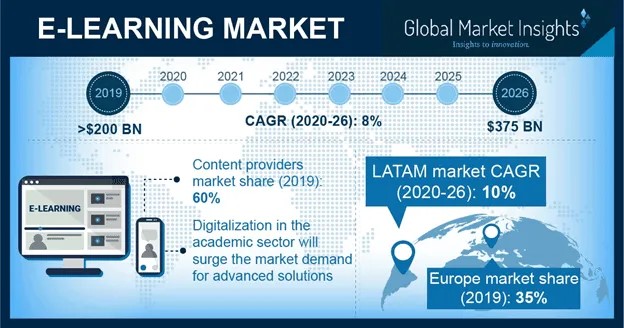
eLearning Gone Wrong? 7 Mistakes to Watch Out for in Education Settings
25th June 2025
Did you know that a global report by Statista projects the eLearning market will surpass $375 billion by 2026, reflecting the growing demand for digital education worldwide?

As digital learning becomes a cornerstone of modern education, school administrators and academic leaders are under increasing pressure to implement e-learning systems that not only deliver content but also enhance engagement, performance, and retention. Yet, despite the best intentions, many rollouts fall short due to avoidable missteps in planning and execution.
However, those educational leaders who have pursued courses like a Level 7 Diploma in Education Management and Leadership, understand that these pitfalls are crucial, not only to drive successful digital transformation but also to lead innovation with strategic foresight and pedagogical balance.
In this blog post, we will explore 7 common mistakes that you should avoid for successful transformation towards eLearning.
So, without any further delay, let’s get started.
Top 7 eLearning Mistakes You Must Avoid in Educational Settings
Rolling out eLearning in schools or academic institutions is more than just integrating tech tools, it’s about transforming how learning happens. But without careful planning, even well-intentioned initiatives can backfire. From neglecting teacher training to choosing platforms that don’t align with pedagogy, here are seven common mistakes educational leaders must steer clear of to ensure eLearning success.
1. Lack of a Clear Vision and Strategy
Rolling out eLearning without a well-defined vision is like setting sail without a compass. Educational leaders must first articulate the "why" behind digital adoption. Is the goal to improve accessibility? Enhance blended learning? Bridge learning gaps? Without alignment on purpose, initiatives can become fragmented, inconsistent, and difficult to evaluate.
2. Ignoring Stakeholder Involvement
A common mistake is leaving key voices out of the planning process. Teachers, students, IT staff, and even parents bring unique insights that can shape successful eLearning ecosystems. When implementation decisions are made in isolation, it often leads to resistance, confusion, or poor adoption.
Tip: Involve teachers early, especially those who are tech-savvy and respected by peers. Their support can significantly influence broader faculty buy-in.
3. Underestimating the Importance of Training
Even the most sophisticated learning platforms will fail if users aren’t properly trained. Teachers may struggle to integrate digital tools into their pedagogy, and students may feel overwhelmed by new interfaces. Training should be ongoing, differentiated, and responsive, not just a one-off orientation session.
4. Choosing Tools Over Pedagogy
Technology should serve pedagogy, not the other way around. Rushing to adopt trendy tools without evaluating their fit for your institution’s teaching style and learning goals often leads to disjointed instruction. Always ask: “How does this tool enhance learning outcomes?”
5. Neglecting Accessibility and Inclusivity
True digital learning is inclusive. Failing to account for students with special needs, limited internet access, or low digital literacy can exacerbate existing inequalities. Educational leaders must ensure that chosen platforms and content meet universal design standards and offer support for diverse learners.
6. Skipping Feedback and Iteration
A rollout isn’t complete once the system is live. Continuous improvement based on real-time feedback from teachers and learners is essential. Collect data on usage, engagement, and outcomes, and be ready to make iterative changes. Institutions that skip this step risk stagnant systems that eventually fall out of use.
7. Overlooking Change Management
Introducing eLearning is a cultural shift, not just a technical upgrade. Change management strategies, including transparent communication, empathy, and visible leadership involvement, are key to reducing resistance and encouraging a smooth transition.
Final Thoughts
Avoiding these common mistakes can set the foundation for a thriving digital learning environment that supports both educators and learners. Educational leaders must strike a balance between vision and execution, policy and practice, and innovation and inclusion.
Those advancing their expertise through qualifications like the Ofqual Level 7 diploma in education leadership are uniquely positioned to lead this transformation with insight, agility, and a learner-first mindset.
Because successful eLearning isn't just about going digital—it's about doing it right.
Frequently Asked Questions (FAQ)
1. What is the biggest mistake schools make when launching eLearning?
One of the most common mistakes is rushing into technology adoption without a clear pedagogical strategy. When tools are prioritized over teaching goals, the outcome often leads to low student engagement and inconsistent implementation across classrooms.
2. How can school leaders ensure teachers are ready for eLearning?
Proper training and ongoing support are essential. Leaders should offer hands-on workshops, peer mentoring, and tech support systems to help teachers feel confident and equipped to use digital tools effectively in their instruction.
3. Why is feedback important during eLearning implementation?
Collecting feedback from students, teachers, and parents helps identify what’s working and what’s not. It allows leaders to make data-driven decisions and continuously improve the digital learning environment.
4. How do we avoid digital equity issues in a school-wide rollout?
Ensure that all students have access to devices, internet connectivity, and accessible learning platforms. Consider learners with disabilities by using inclusive design principles and providing multiple content formats.
5. What role does change management play in eLearning success?
Change management helps prepare stakeholders emotionally and mentally for the transition. Open communication, shared goals, and visible leadership support reduce resistance and foster a collaborative approach to digital transformation.
6. Is eLearning effective for all age groups in school?
Effectiveness varies by age group. While older students may adapt quickly, younger learners often need more structured guidance, parental involvement, and interactive content to stay engaged. Tailoring approaches by grade level is key.
7. How can educational leaders measure the success of eLearning programs?
Use both quantitative data (test scores, platform usage) and qualitative insights (student/teacher feedback, engagement levels) to evaluate outcomes. Ensure that evaluation methods are tied to specific learning objectives and indicators of student progress.
Written By : Park Jin Ae




